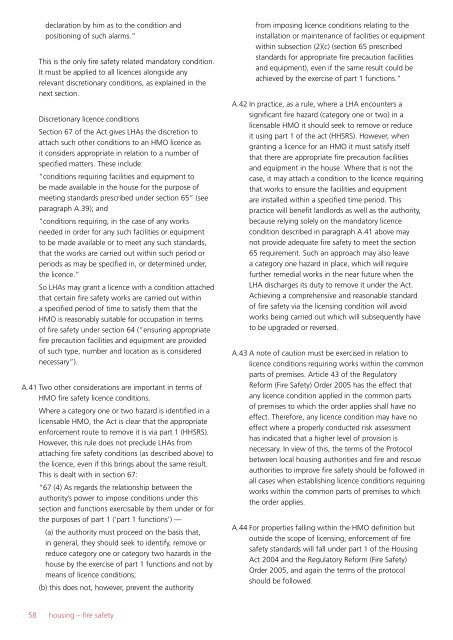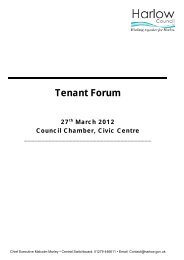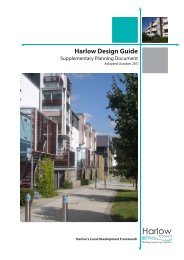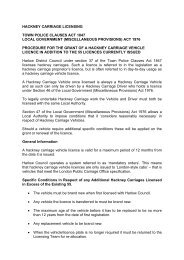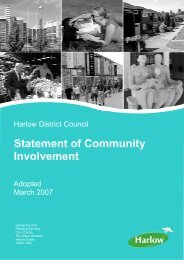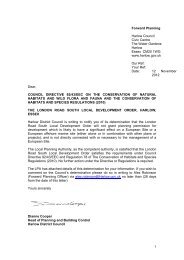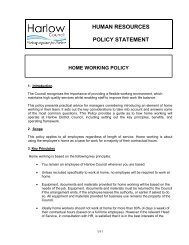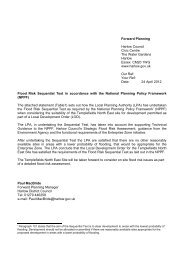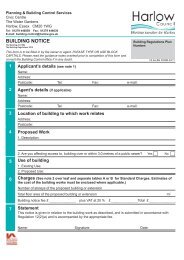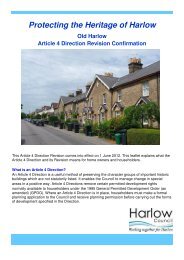HMO fire safety guidance - Harlow Council
HMO fire safety guidance - Harlow Council
HMO fire safety guidance - Harlow Council
You also want an ePaper? Increase the reach of your titles
YUMPU automatically turns print PDFs into web optimized ePapers that Google loves.
declaration by him as to the condition and<br />
positioning of such alarms.”<br />
This is the only <strong>fire</strong> <strong>safety</strong> related mandatory condition.<br />
It must be applied to all licences alongside any<br />
relevant discretionary conditions, as explained in the<br />
next section.<br />
Discretionary licence conditions<br />
Section 67 of the Act gives LHAs the discretion to<br />
attach such other conditions to an <strong>HMO</strong> licence as<br />
it considers appropriate in relation to a number of<br />
specified matters. These include:<br />
“conditions requiring facilities and equipment to<br />
be made available in the house for the purpose of<br />
meeting standards prescribed under section 65” (see<br />
paragraph A.39); and<br />
“conditions requiring, in the case of any works<br />
needed in order for any such facilities or equipment<br />
to be made available or to meet any such standards,<br />
that the works are carried out within such period or<br />
periods as may be specified in, or determined under,<br />
the licence.”<br />
So LHAs may grant a licence with a condition attached<br />
that certain <strong>fire</strong> <strong>safety</strong> works are carried out within<br />
a specified period of time to satisfy them that the<br />
<strong>HMO</strong> is reasonably suitable for occupation in terms<br />
of <strong>fire</strong> <strong>safety</strong> under section 64 (“ensuring appropriate<br />
<strong>fire</strong> precaution facilities and equipment are provided<br />
of such type, number and location as is considered<br />
necessary”).<br />
A.41 Two other considerations are important in terms of<br />
<strong>HMO</strong> <strong>fire</strong> <strong>safety</strong> licence conditions.<br />
Where a category one or two hazard is identified in a<br />
licensable <strong>HMO</strong>, the Act is clear that the appropriate<br />
enforcement route to remove it is via part 1 (HHSRS).<br />
However, this rule does not preclude LHAs from<br />
attaching <strong>fire</strong> <strong>safety</strong> conditions (as described above) to<br />
the licence, even if this brings about the same result.<br />
This is dealt with in section 67:<br />
“67 (4) As regards the relationship between the<br />
authority’s power to impose conditions under this<br />
section and functions exercisable by them under or for<br />
the purposes of part 1 (‘part 1 functions’) —<br />
(a) the authority must proceed on the basis that,<br />
in general, they should seek to identify, remove or<br />
reduce category one or category two hazards in the<br />
house by the exercise of part 1 functions and not by<br />
means of licence conditions;<br />
(b) this does not, however, prevent the authority<br />
from imposing licence conditions relating to the<br />
installation or maintenance of facilities or equipment<br />
within subsection (2)(c) (section 65 prescribed<br />
standards for appropriate <strong>fire</strong> precaution facilities<br />
and equipment), even if the same result could be<br />
achieved by the exercise of part 1 functions.”<br />
A.42 In practice, as a rule, where a LHA encounters a<br />
significant <strong>fire</strong> hazard (category one or two) in a<br />
licensable <strong>HMO</strong> it should seek to remove or reduce<br />
it using part 1 of the act (HHSRS). However, when<br />
granting a licence for an <strong>HMO</strong> it must satisfy itself<br />
that there are appropriate <strong>fire</strong> precaution facilities<br />
and equipment in the house. Where that is not the<br />
case, it may attach a condition to the licence requiring<br />
that works to ensure the facilities and equipment<br />
are installed within a specified time period. This<br />
practice will benefit landlords as well as the authority,<br />
because relying solely on the mandatory licence<br />
condition described in paragraph A.41 above may<br />
not provide adequate <strong>fire</strong> <strong>safety</strong> to meet the section<br />
65 requirement. Such an approach may also leave<br />
a category one hazard in place, which will require<br />
further remedial works in the near future when the<br />
LHA discharges its duty to remove it under the Act.<br />
Achieving a comprehensive and reasonable standard<br />
of <strong>fire</strong> <strong>safety</strong> via the licensing condition will avoid<br />
works being carried out which will subsequently have<br />
to be upgraded or reversed.<br />
A.43 A note of caution must be exercised in relation to<br />
licence conditions requiring works within the common<br />
parts of premises. Article 43 of the Regulatory<br />
Reform (Fire Safety) Order 2005 has the effect that<br />
any licence condition applied in the common parts<br />
of premises to which the order applies shall have no<br />
effect. Therefore, any licence condition may have no<br />
effect where a properly conducted risk assessment<br />
has indicated that a higher level of provision is<br />
necessary. In view of this, the terms of the Protocol<br />
between local housing authorities and <strong>fire</strong> and rescue<br />
authorities to improve <strong>fire</strong> <strong>safety</strong> should be followed in<br />
all cases when establishing licence conditions requiring<br />
works within the common parts of premises to which<br />
the order applies.<br />
A.44 For properties falling within the <strong>HMO</strong> definition but<br />
outside the scope of licensing, enforcement of <strong>fire</strong><br />
<strong>safety</strong> standards will fall under part 1 of the Housing<br />
Act 2004 and the Regulatory Reform (Fire Safety)<br />
Order 2005, and again the terms of the protocol<br />
should be followed.<br />
58<br />
housing – <strong>fire</strong> <strong>safety</strong>


